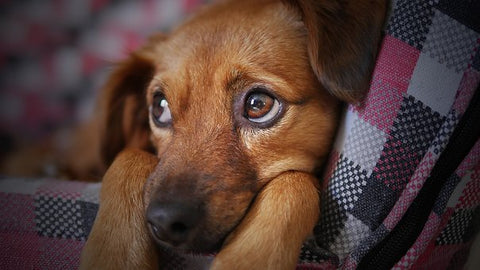I remember the shock of walking into a friend's house and seeing a crate for puppy training because for me it has always felt instinctively cruel to box or confine a pet. However, kennel or crate training generally has increased in popularity over the years as an effective method of developing your puppy's obedience and adherence to routine in the sense that boundaries can actually make your puppy feel safer and more secure. As with any training method, it's the application of the environment that makes a difference between an effective or detrimental outcome.
Sensible Time Frames
Applying the use of a crate for small time periods can help with toilet training and managing aggressive or destructive behaviour but it can also be useful in helping with your puppy's stress and anxiety levels. During this time, it is vitally important that the crate is treated as a 'positive' experience for the puppy as a safe place it can go to feel protected and happy in the same way that a child's bedroom should be a place the child can go to in order to feel they're in their own environment, especially when they're over tired or anxious. If this is done correctly, the dog will retreat to its crate whenever it wants to relax or settle away from the hustle and bustle of the household.
There are multiple advantages to the 'crate' approach, including the development of a puppy's basic natural instincts around toilet training: a puppy will rarely mess where he/she sleeps more than once or twice for all the obvious reasons! This also helps to get your puppy into all the right physical routines for blader and bowel movements. If the crate is a clean and warm place to go, the puppy will quickly adapt to doing its bit to ensure that it stays that way! Having a crate can also help to develop the puppy's anxiety at night as a place he/she feels is a retreat from the dark house environment: do remember that at night every background sound you sleep through is invaraibly a trigger of some sort for your puppy, even if it's simply curious to know what made the noise.
Other incredibly useful times to use the crate can be either directly before or after exercise (it's vitally important to provide the right level of exercise for your puppy once he/she is ready to explore) and at breakfast or other meal preparation times when having a puppy around your feet can be dangerous for you and them. At these times, it is incredibly helpful if they are given a chew or some sort of interactive toy so that the crate is seen as a reward rather than a negative confinement.
Warning: Crate Training is NOT an Easy Way Out
One thing it's vitally important to point out is that crate training is not the easy option when it comes to developing your puppy's routine. It might seem like a way of narrowing access to the rest of the house while he/she learns the rules but it really has to be presented in a positive light and the balance of getting this right actually makes for a difficult challenge all by itself.
What Sort of Crate is Right For My Puppy?
There are almost as many crate, cage and kennel variants on the market as there are dog breeds! These can be plastic, metal, fabric around a metal frame or wooden and come in a wide variety of different types: static, collapsible, fold away or compartmentalised. They also come in a variety of different sizes. Some people prefer a larger crate to ensure that the puppy doesn't feel trapped or overly confined and others prefer a smaller crate because they feel that the puppy will consider itself safer and more secure in a closer environment. The standard advice is that your crate should be large enough for your dog to stand and turn around in. You do need to ensure that the crate will be large enough to accomodate your puppy as it grows so this needs to be taken into consideration when making your crate selection.
The Process of Introduction
1. Make sure the crate is placed in a communal area of the house where the family spends time and not in an isolated or shut-off environment.
2. Put in a soft blanket or padding, perhaps with removable 'cleanable' sheets underneath it (the same sort advised for smaller pets).
3. Put small food bites and/or treats into the crate to warmly welcome your puppy to its occasional home.
4. Introduce your puppy to the crate but do NOT force him into it. Simply ensure that everything that might attract him is inside rather than outside the environment and see what happens. This step may require an enormous amount of patience and constitution!
5. Be sure to give your puppy their meals in the crate so that they are always looking forward to being there.
6. Your puppy's feeding sessions are generally regarded as the best advised times to close the door of the crate/cage but you must ensure that this is not done immediately or suddenly and only leave the door closed initially for very short periods (ie while the puppy is distracted by its enthusiasm for feeding).
7. If the puppy begins to cry or moan at being in the crate, it is vitally important you only let them out when this behaviour stops so that the puppy doesn't associate crying with being released from the environment.
8. Each time your puppy enters the crate, make a fuss of them and give them a treat or reward to positively reinforce the good behaviour.
9. You should spend time sitting beside the crate initially to keep your puppy company, starting with five or ten minutes sessions and slowly decreasing this over time.
10. When your dog is comfortable spending half an hour or so inside the crate, you may tentatively leave the house for small periods of time, increasing this as the dog becomes more comfortable with the environment.
Issues Arising From Crate Trainin
Overexposure to the environment. Keeping your puppy inside the crate for too long can be very damaging and a difficult problem to unpick. It's far easier not to fall into this trap than to undo the effects afterwards. During this time it's really important for you to remember that you are supposed to be catering to your puppy's physical and emotional needs, not your own. If your puppy has been in the crate for any sort of lengthy period, they should then spend a larger amount of time outside it. Puppies should not spend more than three hours in a crate at any one time. If they do, you will make more work for yourself cleaning up the results of their prolonged stay! Seperation anxiety is not cured or helped by confinement, so do ensure that your puppy is not overly stressed about being inside the cage or its desperation to get back to you will be doubled. This is why it's worth restating that you should spend chunks of time sitting beside the crate when you first introduce your puppy to its occasional home. Whining or howling at night is very common in the first week or two of crate training and, as mentioned above, it is important to stay vigilant and reward the cessation of the behaviour rather than unintentionally rewarding the behaviour itself.














